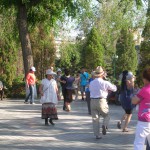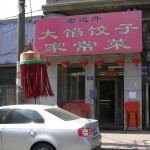Ron’s trip to Harbin
In the paring of 2011 I visited the city of Harbin 哈爾濱. It is located in China’s far northeast, a region we used to refer to as north Manchuria.
The wide and swiftly flowing Songhua River 松花江flows along the city center’s northern boundary. Great crowds enjoy strolling through the park along its banks. A number of snack stands and benches invite one to rest. Children are filled with energy as they run and play. But it is the adults who are flying the irascible Chinese kites, shaped like dragons in blue, or winged birds in red. Every so often a group of middle-aged people gather around a portable CD player to practice ballroom dancing. It’s a time for those wishing public attention to show off, and for all the others to just have some healthy and measured exercise.
Harbin was formed in the late 1800s and by the early 1900s had many Russians living there. The Russian influence is seen in the magnificent Greek Orthodox churches that still stand. They were stripped of inside ornamentation during the Cultural Revolution 文革in the 1960s had have not yet been restored. The grand St. Sophia is used as a gallery of historical photos of old Harbin and had many visitors when I was there.
Other influences of the former Russian presence are also easy to see. The Russian Jewish community used to operate soup kitchens for the destitute, and some of those buildings and also synagogues still stand. The ornate architecture of apartments and hotels built between 1910 and 1930 grace the Central Street 中央街that today is a haven for tourists, both domestic and international. There are many Russian restaurants and bakeries. Most interesting to me were the wheeled carts that fanned out each evening selling Russian breads. Harbin is the only Chinese city I’ve been in where many people on their way home from work in the evening stopped to buy a bag of European breads and rolls.
Since it is so far north, the local Chinese like meals with big chunks of pork or beef. Dripping fat, the better restaurants will supply customers with a set of disposable plastic gloves, since about the only way to tackle the joint of meat is by picking it up and gnawing away like one of the Jurchen tribal peoples 女真族 (forerunners of the Manchus滿族) of old who used to rule the area. Also I saw a lot of restaurants selling “well-stuffed dumplings” 大餡餃子 which are not advertised that way farther south in China.
Harbin is freezing cold from November through the end of March when even the river freezes over, so the huge ice sculptures are a big tourist draw in the winter. The fire department simply sprays the trees in some parks, and the water stays frozen there until the springtime. Because the winter is so bitter, I asked a taxi driver what he would say to me about visiting Harbin in the cold months. “Oh, it’s wonderful,” he said, “The snow falls and everything is white. The snow sparkles like crystals.”
Ronald Suleski
Rosenberg Institute, Suffolk University
July 2011



